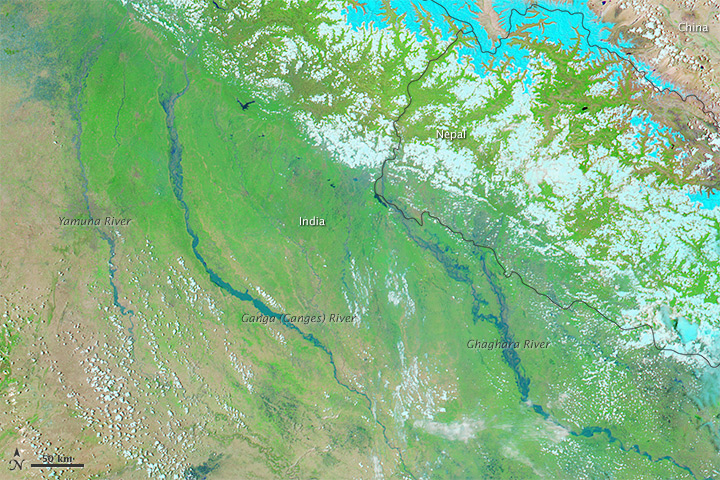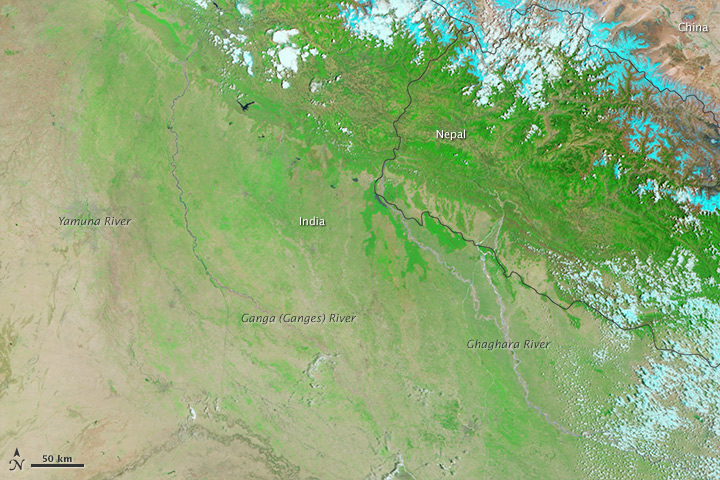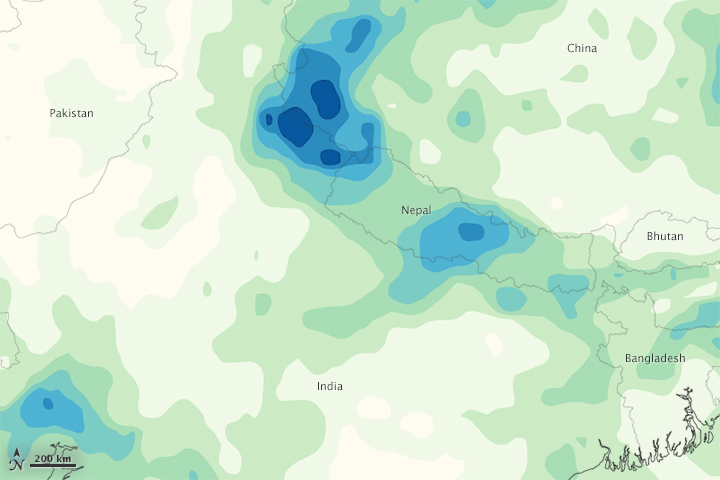
acquired June 21, 2013
download large image (5 MB, JPEG, 6000x4000)
acquired June 21, 2013
download GeoTIFF file (42 MB, TIFF)

acquired May 30, 2013
download large image (5 MB, JPEG, 6000x4000)
acquired May 30, 2013
download GeoTIFF file (41 MB, TIFF)

acquired June 14 - 20, 2013
In mid-June 2013, unusually severe
monsoon rain caused devastating flooding in northern India and Nepal. By
June 21, news outlets reported at least 600 people dead and tens of
thousands stranded or missing in rugged, inaccessible terrain on the
edge of the Himalayas. Extremely high waters, particularly in the state
of Uttarakhand, undermined roads and houses, while landslides wiped out others.
Landslide researcher David Petley noted
on his blog: “Whilst mid-June is monsoon season in this area, the most
intense rainfall usually occurs later than this. Unfortunately, this
high intensity rainfall event will have saturated the ground in these
areas, making them more vulnerable to landslides later in the summer.”
The Moderate Resolution Imaging Spectroradiometer (MODIS) on NASA’s Aqua
satellite observed the flooding on June 21, 2013 (top). For comparison,
the lower image shows the same area on May 30, 2013. These false-color
images use a combination of visible and infrared
light to make it easier to distinguish between water and land. Water
appears blue and vegetation is bright green. Clouds (lower left) are
pale blue-green and cast shadows. Glacier ice and snow in the Himalayas
are pale blue to cyan.
The third image is a map of rainfall totals in India, Nepal, and
surrounding countries from June 14-20, 2013. The heaviest
rainfall—greater than 300 millimeters (12 inches)—appears in dark blue.
The lightest rainfall (less than 15 millimeters, or 0.6 inches) appears
in light green. Trace amounts of rain appear in yellow.
The map is based on data from NASA’s Multisatellite Precipitation
Analysis (MPA), which estimates rainfall by combining measurements from
several satellites and calibrating them using measurements from the Tropical Rainfall Measuring Mission
(TRMM). Because it is an estimate of rainfall over a very large area
and based on when satellites pass overhead, the MPA may miss pockets of
heavy rain in smaller areas, or short periods of more or less intense
rain. As a result, local rainfall totals measured from the ground may
differ from the estimates shown here.
Further Reading
- Associated Press, via Yahoo News (2013, June 21) Death toll in Indian monsoon flooding nears 600. Accessed June 21, 2013.
- NDTV (2013, June 19) Road to Kedarnath: see the damage in epicentre of rain fury. Accessed June 21, 2013.
- The Landslide Blog by David Petley (2013, June 21) The Kedarnath debris flow disaster in Uttarakhand. Accessed June 21, 2013.
- The Landslide Blog by David Petley (2013, June 18) The monsoon arrives early in northern India and Nepal, inflicting a high cost. Accessed June 21, 2013.
NASA Earth Observatory image by Jesse Allen, using data from the Land Atmosphere Near real-time Capability for EOS (LANCE). Caption by Mike Carlowicz.
- Instrument:
- Aqua - MODIS
NASA: India - Nepal - Severe Flooding - 19.07.13
Ricardo M Marcenaro - Facebook
Blogs in operation of The Solitary Dog:
Solitary Dog Sculptor:
http://byricardomarcenaro.blogspot.com
Solitary Dog Sculptor I:
http://byricardomarcenaroi.blogspot.com
Para:
comunicarse conmigo,
enviar materiales para publicar,
propuestas comerciales:
marcenaroescultor@gmail.com
For:
contact me,
submit materials for publication,
commercial proposals:
marcenaroescultor@gmail.com
My blogs are an open house to all cultures, religions and countries. Be a follower if you like it, with this action you are building a new culture of tolerance, open mind and heart for peace, love and human respect.
Thanks :)
Mis blogs son una casa abierta a todas las culturas, religiones y países. Se un seguidor si quieres, con esta acción usted está construyendo una nueva cultura de la tolerancia, la mente y el corazón abiertos para la paz, el amor y el respeto humano.
Gracias :)

No hay comentarios:
Publicar un comentario